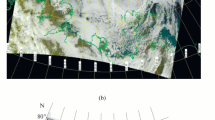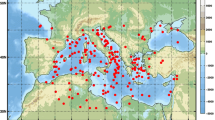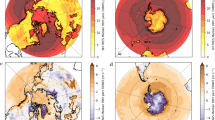Abstract
Extreme midlatitude cyclone characteristics, precipitation, wind speed events, their inter-relationships, and the connection to large-scale atmospheric patterns are investigated in simulations of a prolonged cold period, known as the Maunder Minimum from 1640 to 1715 and compared with today. An ensemble of six simulations for the Maunder Minimum as well as a control simulation for perpetual 1990 conditions are carried out with a coupled atmosphere-ocean general circulation model, i.e., the Climate Community System Model (CCSM). The comparison of the simulations shows that in a climate state colder than today the occurrence of cyclones, the extreme events of precipitation and wind speed shift southward in all seasons in the North Atlantic and the North Pacific. The extremes of cyclone intensity increases significantly in winter in almost all regions, which is related to a stronger meridional temperature gradient and an increase in lower tropospheric baroclinicity. Extremes of cyclone intensity in subregions of the North Atlantic are related to extremes in precipitation and in wind speed during winter. Moreover, extremes of cyclone intensity are also connected to distinct large-scale atmospheric patterns for the different subregions, but these relationships vanish during summer. Analyzing the mean 1,000 hPa geopotential height change of the Maunder Minimum simulations compared with the control simulation, we find a similar pattern as the correlation pattern with the cyclone intensity index of the southern Europe cyclones. This illustrates that changes in the atmospheric high-frequency, i.e., the simulated southward shift of cyclones in the North Atlantic and the related increase of extreme precipitation and wind speed in particular in the Mediterranean in winter, are associated with large-scale atmospheric circulation changes.











Similar content being viewed by others
References
Arends F (1833) Physische Geschichte der Nordseeküste und deren Veränderungen durch Sturmfluthen seit der Cymbrischen Fluth bis jetzt. Emden, Germany
Beersma JJ, Rider KM, Komen GJ, Kaas E, Kharin V (1997) An analysis of extra-tropical storms in the North Atlantic region as simulated in a control and 2 × CO2 time-slice experiment with a high-resolution atmospheric model. Tellus 49:347–361
Bengtsson L, Hodges KI, Roeckner E (2006) Storm tracks and climate change. J Clim 19:3518–3543
Björck S, Clemmensen LB (2004) Aeolian sediment in raised bog deposits, Halland, SW Sweden: A new proxy record of Holocene winter storminess variation in southern Scandinavia. Holocene 14:677–688
Blender R, Schubert M (2000) Cyclone tracking in different spatial and temporal resolutions. Mon Wea Rev 128:377–384
Blender R, Fraedrich K, Lunkeit F (1997) Identification of cyclone-track regimes in the North Atlantic. Q J Roy Meteor Soc 123:727–741
Böning CW, Döscher R, Isemer HJ (1991) Monthly mean wind stress and Sverdrup transports in the North Atlantic: a comparison of Hellerman–Rosenstein and Isemer–Hasse Climatologies. J Phys Ocean 21:221–235
Bradley RS, Jones PD (1993) ‘Little Ice Age’ summer temperature variations: their nature and relevance to recent global warming. Holocene 3:367–376
Bradley RS, Briffa KR, Cole J, Hughes MK, Osborn TJ (2003) The climate of the last millennium. In: Alverson K, Bradley RS, Pedersen TF (eds) Paleoclimate, global change, and future. Springer, Berlin Heidelberg New York, pp 105–141
Briegleb BP, Bitz CM, Hunke EC, Lipscomb WH, Holland MM, Schramm JL, Moritz RE (2004) Scientific description of the sea ice component in the community climate system model, Version 3, National Center for Atmospheric Research, Boulder, CO.80307-3000, Tech. Report, 77pp
Broecker WS (2000) Was a change in the thermohaline circulation responsible for Little Ice Age? Proc Nat Acad Sci USA 97:1339–1342
Casty C, Handorf D, Raible CC, Luterbacher J, Weisheimer A, Xoplaki E, González-Rouco JF, Dethloff K, Wanner H (2005a) Recurrent climate winter regimes in reconstructed and modelled 500 hPa geopotential height fields over the North Atlantic-European sector 1659–1990. Clim Dynam 24:809–822. DOI 10.1007/s00382-004-0496-8
Casty C, Handorf D, Sempf M (2005b) Combined winter climate regimes over the North Atlantic/European sector 1766–2000. Geophys Res Lett 32. DOI 10.1029/2005GL022431
Cook ER, D’Arrigo RD, Mann ME (2002) A well-verified, multiproxy reconstruction of the winter North Atlantic Oscillation index since A.D. 1400. J Clim 15:1754–1764
Crowley TJ (2000) Causes of climate change over the past 1000 years. Science 289:270–277
De Jong R, Björck S, Björkman L, Clemmensen LB (2006) Storminess variations during the last 6500 years as reconstructed from and ombrotrophic bog in Halland, SW Sweden. J Quat Science (in press)
Eady ET (1949) Long waves and cyclone waves. Tellus 1:33–52
Esper J, Cook ER, Schweingruber FH (2002) Low-frequency signals in long tree-ring chronologies for reconstructing past temperature variability. Science 295:2250–2253
Fischer-Bruns I, von Storch H, González-Rouco JF, Zorita E (2005) Modelling the variability of midlatitude storm activity on decadal to century time scales. Clim Dyn 21. DOI 10.1007/s00382-005-0036-1
González-Rouco FJ, von Storch H, Zorita E (2003) Deep soil temperature as a proxy for surface temperature in a coupled model simulation of the last thousand years. Geophys Res Lett 30. DOI 10.1029/2003GL018264
Haigh JD (1994) The role of stratospheric ozone in modulating the solar radiative forcing of climate. Nature 370:544–546
Hendy EJ, Gagan MK, Alibert MT, McCulloch MT, Lough JM, Isdale PJ (2002) Abrupt decrease in tropical Pacific sea surface salinity at end of Little Ice Age. Science 295:1511–1514
Hurrell JW (1995) Decadal trends in the North Atlantic oscillation: regional temperatures and precipitation. Science 269:676-679
IPCC (2001) Climate change 2001: the scientific basis. Cambridge University Press, Cambridge. Contribution of working group i to the third assessment report of the Intergovernmental Panel on Climate Change, 881pp
Jakubowski-Tiessen M (1992) Sturmflut 1717: die Bewältigung einer Naturkatastrophe in der Frühen Neuzeit. R. Oldenbourg, München, p 315
Jones PD, Mann ME (2004) Climate over the past millennia Rev Geophys 42(RG2002). DOI 10.1029/2003RG000143
Jones PD, Briffa KR, Barnett TP, Tett SFB (1998) High-resolution paleoclimatic records for the last millennium: interpretation, integration, and comparison with general circulation model control-run temperatures. Holocene 8:455–471
Katz RW, Brown BG (1992) Extreme events in a changing climate— variability is more important than averages. Clim Change 21:289–302
Kharin VV, Zwiers F (2000) Changes in extremes in an ensemble of transient climate simulations with a coupled atmosphere–ocean GCM. J Clim 13:3760–3788
Kharin VV, Zwiers F (2005) Estimating extremes in transient climate change simulations. J Clim 18:1156–1173
Kiehl JT, Gent PR (2004) The Community Climate System Model, version 2. J Clim 17:3666–3682
Knippert P, Ulbrich U, Speth P (2000) Changing cyclones and surface wind speed over the North Atlantic and Europe in a transient GHG experiment. Clim Res 15:109–122
Lean J, Beer J, Bradley RS (1995) Reconstruction of solar irradiance since 1600: implications for climate change. Geophys Res Lett 22:3195–3198
Leckebusch GC, Ulbrich U (2004) On the relationship between cyclones and extreme windstorm events over Europe under climate change. Global Planet Change 44:181–193
Lindzen RS, Farrell B (1980) A simple approximate result for the maximum growth rate of baroclinic instabilities. J Atmos Sci 37:1648–1654
Lunkeit F, Fraedrich K, Bauer SE (1998) Storm tracks in a warmer climate: sensitivity studies with a simplified global circulation model. Clim Dyn 14:813–826
Luterbacher J, Rickli R, Xoplaki E, Tinguely C, Beck C, Pfister C, Wanner H (2001) The late Maunder Minimum (1675–1715)—a key period for studying decadal scale climatic change in Europe. Clim Change 49:441–462
Luterbacher J, Xoplaki E, Dietrich D, Rickli R, Jacobeit J, Beck C, Gyalistras D, Schmutz C, Wanner H (2002) Reconstruction of sea level pressure fields over the Eastern North Atlantic and Europe back to 1500. Clim Dyn 18:545–561
Mann ME, Bradley RS, Hughes MK (1999) Northern hemisphere temperatures during the past millennium: inferences, uncertainties, and limitations. Geophys Res Lett 26:759–762
Meehl GA, Zwiers F, Evans J, Knutson T, Mearns L, Whetton P (2000) Trends in extreme weather and climate events: issues related to modeling extremes in projections of future climate change. B Am Meteorol Soc 81:427–436
Pauling A, Luterbacher J, Casty C, Wanner H (2006) 500 years of gridded high-resolution precipitation reconstructions over Europe and the connection to large-scale circulation. Clim Dynam 26:387–405. DOI 10.1007/s00382-005-0090-8
Raible CC, Blender R (2004) Midlatitude cyclonic variability in GCM-simulations with different ocean representations. Clim Dyn 22:239–248
Raible CC, Casty C, Luterbacher J, Pauling A, Esper J, Frank DC, Büntgens U, Roesch AC, Wild M, Tschuck P, Vidale PL, Schär C, Wanner H (2006) Climate variability—observations, reconstructions and model simulations. Clim Change (in press)
Rind D, Shindell DT, Perlwitz J, Lerner J, Lonergan P, Lean J, MacLinden C(2004) The relative importance of solar and anthropogenic forcing of climate change between the Maunder Minimum and the present. J Clim 17:906–929
Schaeffer M, Selten FM, Opsteegh JD (2005) Shifts of means are not a proxy for changes in extreme winter temperature in climate projections. Clim Dyn 25:51–63
Schär C, Vidale PL, Lüthi D, Häberli C, Liniger MA, Appenzeller C (2004) The role of increasing temperature variability in European summer heatwaves. Nature 427:332–336
Shindell DT, Rind D, Balachandran N, Lean J, Lonergan P (1999) Solar cycle variability, ozone, and climate. Science 284:305–308
Shindell DT, Schmidt GA, Mann MA, Rind D, Waple A (2001) Solar forcing of regional climate change during the Maunder Minimum. Science 294:2149–2152
Sickmöller M, Blender R, Fraedrich K (2000) Observed winter cyclone tracks in the Northern Hemisphere in re-analysed ECMWF data. Q J R Meteorol Soc 126:591–620
Simmons AJ, Gibson JK (2000) The ERA-40 project plan. Technical Report, ECMWF, Shinfield Park, Reading, 63pp
Wajsowicz RC (2002) A modified Sverdrup model of the Atlantic and Caribbean circulation. J Phys Ocean 32:973–993
Yin JH (2005) A consistent poleward shift of storm tracks in simulations of 21st century. Geophys Res Lett 32. DOI 10.1029/2005GL023684
Yoshimori M, Stocker TF, Raible CC, Renold M (2005) Externally-forced and internal variability in ensemble of climate simulations of the Maunder Minimum. J Clim 18:4253–4270
Yoshimori M, Raible CC, Stocker TF, Renold M (2006) On the interpretation of low-latitude hydrological proxy records on Maunder Minimum AOGCM simulations. Clim Dyn. DOI 1007/s00382-006-0144-6
Zorita E, von Storch H, González-Rouco JF, Cubasch U, Luterbacher J, Fischer-Bruns I, Legutke S, Schleese U (2004) Climate evolution in the last five centuries simulated by an atmosphere-ocean model: global temperatures, North Atlantic Oscillation and the late Maunder Minimum. Meteorol Z 13:271–289
Acknowledgments
We thank Guido Poliwoda for the historical references. This work is supported by the National Centre for Competence in Research (NCCR) on Climate funded by the Swiss National Science Foundation. Simulations are carried out at the Swiss National Computing Centre in Manno, Switzerland. CC is supported by the European Project entitled “Patterns of Climate Variability in the North Atlantic (PACLIVA, EVR1-2002-000413)”. This is IPRC contribution # 389. TFS is partially supported by the IPRC Visitor Program. ERA-40 reanalysis data were provided by European Centre for Medium-Range Weather Forecasts (http://www.data.ecmwf.int/data/index.html).
Author information
Authors and Affiliations
Corresponding author
Rights and permissions
About this article
Cite this article
Raible, C.C., Yoshimori, M., Stocker, T.F. et al. Extreme midlatitude cyclones and their implications for precipitation and wind speed extremes in simulations of the Maunder Minimum versus present day conditions. Clim Dyn 28, 409–423 (2007). https://doi.org/10.1007/s00382-006-0188-7
Received:
Accepted:
Published:
Issue Date:
DOI: https://doi.org/10.1007/s00382-006-0188-7




